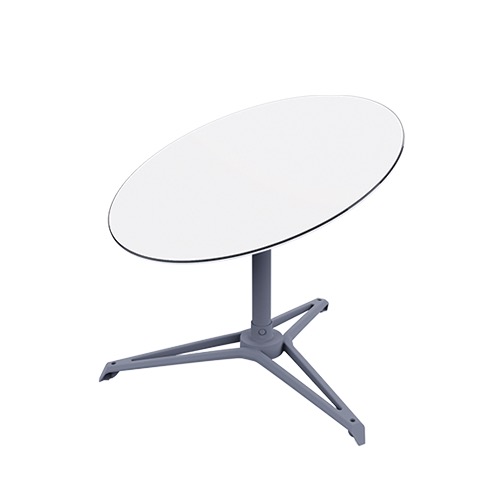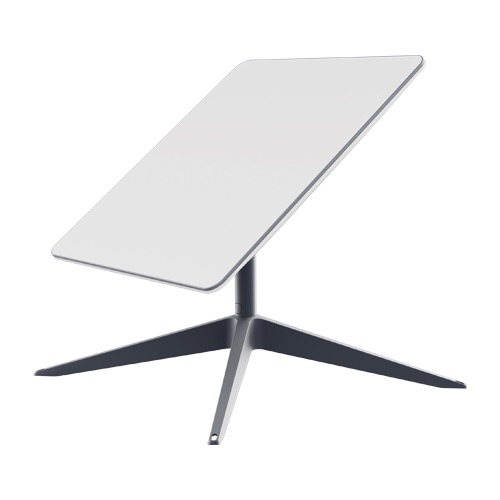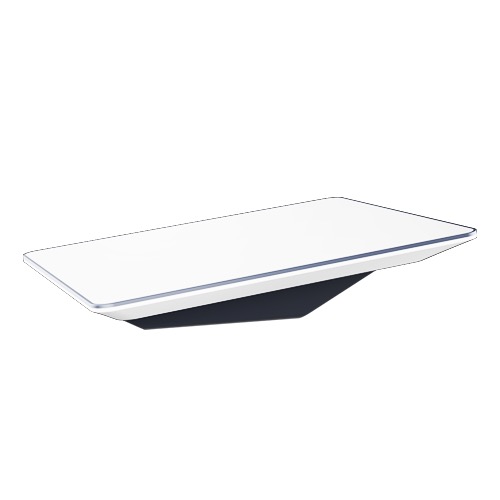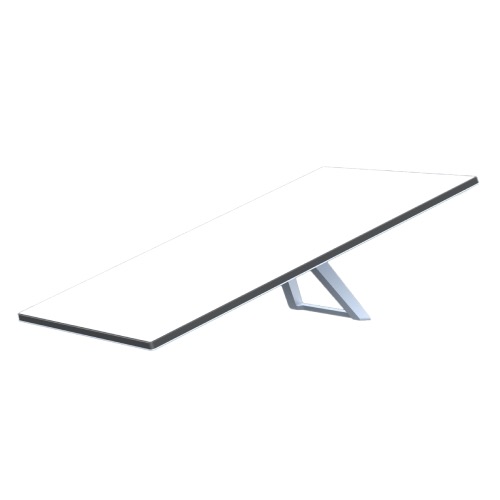If you plan to use Starlink for your RV, boat, or off-grid cabin, knowing the electrical requirements for Starlink is critical. Even if are just using Starlink at home, you may be wondering how much power the Starlink dish uses.
In this article, I will explain the power consumption for all models of the Starlink antenna: Gen 1 Standard Circular, Gen 2 Standard Actuated, Gen 2 High Performance, Gen 2 Flat High Performance, and Gen 3 Standard. I will also explain the factors that affect power consumption.
Table of Contents
Gen 1 Standard Circular

The original, Gen 1 Standard Circular Starlink dish uses 65-150 watts on average. Starlink didn’t publish the official specifications for the round dish, but I was able to estimate this amount based on my own experience and reports from other users.
Idle usage is between 40-50 watts.
The round dish runs off of AC power, 100-240V, 50-60Hz, and it is estimated to use up to about 5 amps. Power to the Gen 1 dish is supplied through a power brick.
Gen 2 Standard Actuated

The Gen 2 Standard Actuated Starlink dish uses 50-75 watts on average. This includes the antenna, router, power supply, and cables.
When there is no network activity, the Standard Starlink uses about 20 watts to remain connected to the satellite network.
Starlink runs off of 100-240V AC, 50-60Hz. It draws up to 2 amps. On the Gen 2 system, the power supply is integrated within the Wifi router. Starlink does not offer a DC power supply. I did build my own 12V DC power supply, so check that tutorial out if you are interested.
Gen 2 High Performance and Flat High Performance

The Gen 2 High Performance and Flat High Performance Starlink dish uses 110-150 watts on average. This includes the antenna, router, power supply, and cables.
When idle, High Performance uses about 45 watts.
The Gen 2 High Performance models have a separate power supply brick that runs off of 100-240V AC, 50-60Hz. It draws up to 6.3 amps.
Gen 3 Standard

The Gen 3 Standard Starlink dish uses 75-100 watts on average. This includes the antenna, router, power supply, and cables.
When idle, the Gen 3 Standard dish uses about 20 watts.
The Gen 3 Standard model uses a power supply brick that runs off of 100-240V AC, 50-60Hz. It draws up to 2.5 amps.
Factors that affect power consumption
The amount of power that Starlink draws depends on many factors. For example, the Starlink dish will use additional power when it’s snowing or raining. It will use less power when nobody is downloading or uploading anything.
Weather
Weather is the biggest factor to consider in terms of power consumption. During rain or snow, more transmitting and receiving power is required, so power usage can increase significantly. The dish will also automatically melt snow and ice, which uses even more power.
Network activity
Starlink is an antenna that receives and transmits data from satellites orbiting overhead. It takes more power to transmit data than to receive it. If you are uploading data, Starlink will use more power. If you are downloading, Starlink uses less power.
When there is no network activity (idle), Starlink still uses a bit of power, but it is significantly less than when you are downloading or uploading.
Obstructions
If you have trees or other obstructions that block the signal from the Starlink satellites, your Starlink will use more power as it tries to continually re-establish a connection with the satellites.
Related: Sleep Schedule Feature Added To Starlink App

Questioning your answer here. SpaceEx/Starlink haven’t really moved away from PoE. PoE still exists from router to dish. If it wasnt, dish will need its own power supply. All that has happened is that the power brick is a separate unit to the router under Gen3.
I’m confused on what answer you are referring to. You are correct, Gen 3 uses a separate power supply device that plugs into the router, which provides power to the dish via POE.
Thank you for the info!
I live off grid completely, I run a generator a few hours each evening when it gets dark for light and to charge my devices. I currently have satellite internet through HughesNet and it’s a nightmare.
I’m considering working from home out here but before I invest in the Starlink set up, I’m considered about powering it throughout the day.
I’m familiar with the battery packs but unsure of what size I would need. I’m looking to do this relatively inexpensively because I’m not sure how long I’ll be living off grid at the moment.
Any help would be greatly appreciated! Thank you
I use an Ecoflow River 2, and that can power my Starlink for a few hours pretty easily. On average, a Gen 2 system will use around 50 watts. So to evaluate your battery needs, just add up all your loads, and divide the watt hour capacity of the portable power bank by the watts that you require to see about how long it would run it.
Real world results from my experience camping with my v2 Starlink. I have a 1480 watt hour portable power pack. That probably means its got about 1300 usable watt hours of power.
Starting fully charged, if I am actively using the internet for 4-6 hours and then set the unit to “sleep” at night, I will wake up with about 20% battery left. If I just shut off my inverter (and therefore power tot he starlink) I will wake up to about 60% of my power available.
Bottom line, the “sleep schedule” puts me in too deep of a deficit to be able to come back with a 220w solar panel the next day, so I have to really maximize the efficiency of my time online and then shut the system down when I’m not. This makes being able to take phone call for slack messages after hours a problem obviously. If you need that, then you’ll need about around 2,000 watt hours of battery and probably 400 watts of solar charging ability
Thank so much for your awesome info! I’m wanting off grid capability for my Starlink in my RV. I have 2 golf cart batteries (lead acid 440 amp total, 220 amp usable) and 1 – 200 watt solar panel. If I add another panel will that be enough to run Starlink for most of the day, put it to sleep at night? I’m thinking adding an 1800 watt dual fuel QUIET generator for supplemental power. That? or a supplemental power station. What do recommend for supplemental power,?
Thanks again!
As is, that’s plenty of power just for Starlink. If you have other uses for this power, it depends on the draw from the other devices. I never really recommend a gas generator when solar + larger capacity batteries is an option. You can always upgrade to lithium to get more useable capacity. Combined with more solar to charge the higher capacity, you should have plenty of power.
Have an off-grid power question. We run a Yeti Goal Zero 1500 for our van. It was never meant to be lived in full time, so 1500 works great. We’d like to get Starlink for the remote areas of CO and have a few friends who use it and works w video conference meetings, which is the reason to get it. We also run 200W solar panels on the van- most days it’s sunny in CO so usually not an issue. We run a lower power fridge (only draws a few W /hour to keep cool) and usually the ceiling fan. With additional 75w Starlink, would we get through 8 hr work day and still have some charge left (assuming solar is adding 60-100w during the day)? Thanks in advance!
With 1500 Wh of capacity plus solar charging during the day, you shouldn’t have any problems.
Wondering if the new gen 3 router paired with the original round dish will use less power?
Off grid user in northern maine. Ty
Probably not. The Gen 1 router was powered from the same power brick as the dish, through POE. The new Gen 3 router uses its own 60 watt power supply. Since they decided to move away from POE and use a power adapter just for the router, I’m sure it has a higher peak power consumption.
Question, just found your site and info-thanks–
I am in North CA and we have these horrid PGE PSPs where they shut us down for “wind/fire” etc.
We have a whole home generator, but running that monster constantly for more than 24 hours (especially at night) is just not feasible. Especially as my special needs son hates the sound of it.
But, I need to access to the Internet–I work IT for major hospitals and am on call a lot–I also need the Internet for Cell Service. I cant get anything out where I am without it..
To mitigate having to use the whole home unit all the time, or at nights, we bought some portable indoor genies…
But, the issue is, when power goes off they are not handling the Starlink for long enough. Especially at night.
I am trying to determine the whole power consumption on my Starlink- in order to find a portable genie that will handle it for say the 10-12 hours of overnight coverage I need for cell service etc…when on call.
(PS I do have a backup of DSL from local phone company, but they tend to lose their connections when PGE shuts us all down in same area–so that backup is worthless- LOL)
Any idea on what I would need to cover the Starlink? My 500w portables arent doing the job ( I have two one for hubbys CPAP the other for internet).
Any info would be great…thanks
If I were in your situation, I would look into a larger portable power station. Something with 1000+ Wh of capacity. Something of that size can run Starlink for almost a day on battery alone. If you need more than that, you will have to add solar panels to charge the power station. A dedicated power station for Starlink would be ideal, and you can use your other portables for other items you need.
Your numbers are all over the place…uses up to 100W but @ 120V draws up to 5A? That’s over 500-600W nominal.
What do the specs on the power supply actually say? They’re required to be stamped on the power supply and device, by law.
Those are the ratings from the power supply. So there will be a difference between what the hardware will actually use, vs what the power supply is rated at.
So if I power it off for the night and turn it back on in the morning does it have to recycle through a start up process or will it just resume connectivity.
It will just resume connectivity after a few minutes of searching for satellites. You won’t have to go through the setup process again.
Off grid issues do create some doubt as to affordability. Sleep schedule is helpful, but would bypass to a low power router and turning off wifi add further savings?
It could potentially. But just staying connected to the satellites seems to be the main power draw when you aren’t actively using internet services.
How much does it cost to run a starlink system per hour. 75 to 100 watts is stated however it does not give over what period this wattage is used ie ( per hour /per day).
The wattage would be the load at any given time, not as a rate.
How much does it cost to run a starlink system per hour?
Depends on your electricity rate.
Thank you for so many ads blocking content, captchas and more.
After all who is here just seeking specific information.
Noah, 2A at 120V is 240W not 50-75W for the standard dish, right?
True, the 2A is just the rating on the power supply output, not necessarily how much it would ever use.
Can you turn it off when not using it (overnight)? Maybe save 1 kilowatt-hour per day for HP hardware?
You could, although I wouldn’t recommend it unless it’s the mobile/RV/off-grid use case. Idle power usage is so low that realistically I don’t think it would be worth being without internet overnight for the savings. Lots of devices are still using data overnight. For example, phone cloud backup, Starlink firmware updates, etc.
I’m on solar power. At times we turn it off completely will this cause a problem?
No, it shouldn’t cause an issue.
On the Standard model, between 50 -75 is exactly 62.5 Watts x 24 hours = 1,5 kWh per day, on a off-grid cabin, thats huuuge. So, “I don’t think it would be worth being without internet overnight for the savings” on a sububurban home, got it, but your article begins with “If you plan to use Starlink for your RV or off-grid cabin”. Man, empathy please!
Starlink just released a sleep schedule feature which might interest those living off-grid:
https://www.starlinkhardware.com/sleep-schedule-feature-added-to-starlink-app/
Drops power down to around 20-25 watts during the sleep hours.
It’s also important to note the 50-75w is for active use, the dish could idle as low as 20 watts in good weather with no activity. So the math there is worst case scenario. If you have snow or rain, power usage will be towards 100w unless you turn off the snow melting function.
If everyone saves just a bit it adds up, exponentialy more on a long term scale.
I use solar power. At certain times we turn it completely off for extended periods. Will this cause a negative impact?
Can you fit any more ads on this site? Won’t be back!
I apologize if the ads are annoying. I put a lot of time and effort into providing all this free information, so the ads are a way to recoup some of that investment and make it worthwhile. I highly suggest using an ad-blocker like uBlock Origin if you find the ads annoying. That will get rid of all the ads on this site if you ever need to return in the future. Thanks for reading and your feedback!
Hey I have a friend that is a teacher in Ukraine. They’re often without power for the majority of the day with the time they do have power everything must’ve charged. I’m guess she’s at most 3 hours a day with power. I want to get her a starlink so she can conduct her lessons on line and a power stations that’s available for her to pick up which is 600-630w/h capacity and takes four hours to fully charge. I’m not a math or electric person so this stuff i beyond me. She’d need to use the power station to power her laptop for class possibly and lamp and the starlink. Is this a pipe dream idea or is it at All plausible ? Any suggestion or pointing me to the right resource would be extremely appreciated. I’m next to almost calling Elon for some advice. Ha thanks.
If we say the Starlink dish uses 75 watts on average, a 600 w/h power source would power the dish for 8 hours or so, assuming perfect efficiency and no other devices connected. Being conservative, with a laptop and projector, you can probably get several hours of battery life from this power source.
So when the power station dies what happens to the starlink unit?
It would just power down and lose internet connectivity. It doesn’t harm the equipment.
Also, i she has a fuel generator as back up that is single phased with 220v (50hz) would that be too much ?
Nope, the power supply can handle inputs of 100-240V, 50-60Hz, so that should work fine.
Different countries run on different outlets and voltages, I doubt it will be an issue but keep it in mind.
I don’t mind the ads.. .. Thanks for your time on hardware I use… I have to set up a clients page with ads how much u pullin in a week? I know that’s personal..